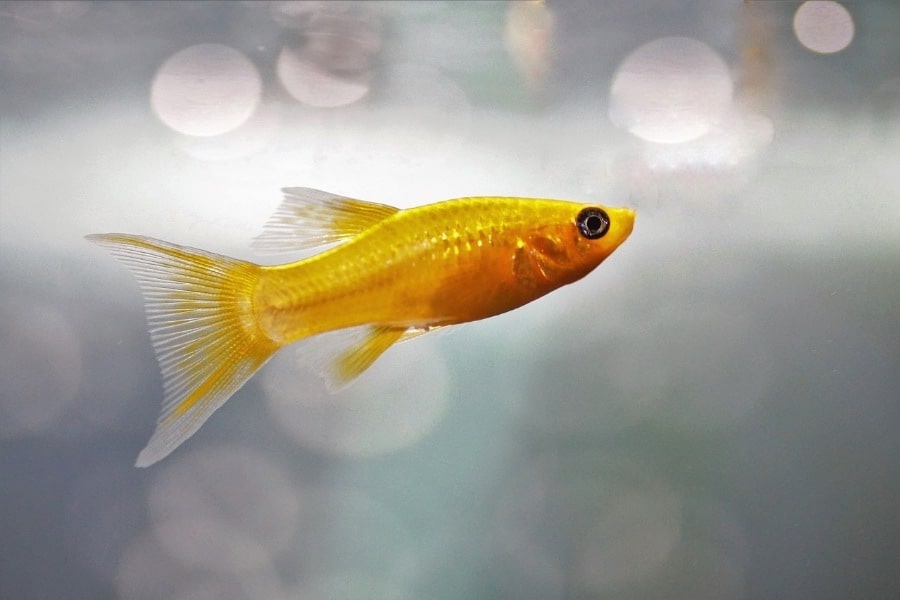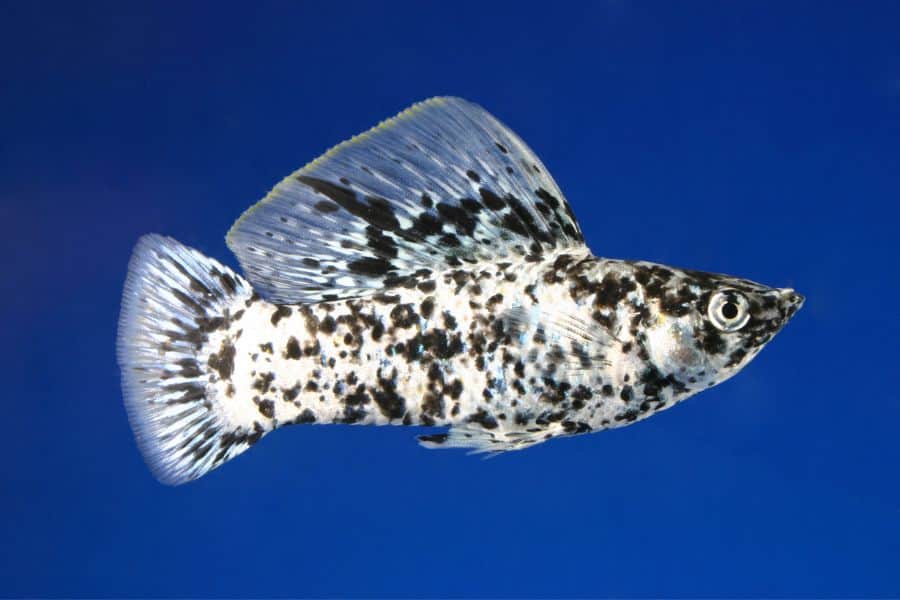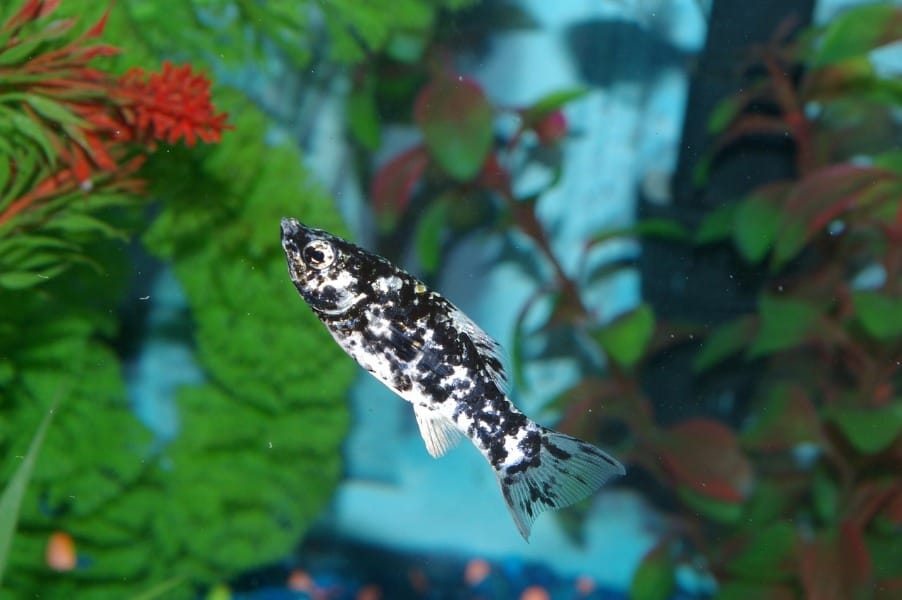It’s not unusual for Molly enthusiasts to wonder how long their pets will live. If you’ve been scouring the internet for Molly fish life expectancy stats, you’ve come to the right place.
This article will highlight the lifespans of popular Molly fish types. There’s also a detailed section on improving lifespan and quick care guide stats.
All you have to do is read on to learn all there is to Molly longevity!
How Long Do Mollies Live In Captivity?
Common Mollies (Poecilia sphenops) can live up to three to five years in captivity. The species generally tend to live longer (touch the five-year mark) in the wild. This phenomenon is observed in most fish species. It likely has to do with the ample space and food supply.
Aquarists should note that the average lifespan stats for Molly fish can vary based on several factors. These include the quality of care and diet, absence of disease, etc.
How Long Do Balloon Belly Mollies Live?
Balloon Belly Mollies have an average life expectancy of two to five years. These are a fancy, hybridized version of Sailfin Mollies. In other words, a manufactured or breeder-developed Molly type.
These fish are generally born with a genetic defect that causes their spines to grow curved. They’re also slow swimmers and feeders. That means they need ideal tank mates to avoid injuries or food competition. With the proper care and optimal settings, Balloon Mollies can live long and healthy lives.
How Long Do Black Mollies Live?
Black Mollies are a Sailfin Molly variant and live up to three years. For some reason, their lifespan isn’t as long as other Molly types.
Fish keepers should note the average life expectancy of Black Mollies assumes top-notch care and diet. That means you might have to shower your Black Molly with more attention than your other finned friends.
How Long Do Sailfin Mollies Live?
Sailfin Mollies (Poecilia latipinna) are pretty hardy and have a lifespan of three-to-five years. These fish can survive in fresh, brackish, and salt water, making them highly adaptable.
This Molly type comes highly recommended for beginner aquarists as they’re easy to care for. They can also tolerate a wide variety of tank setups.
How Long Do Dalmation Mollies Live?
Dalmation Mollies are renowned for their black-and-white patterns. These fish can live anywhere between three to five years if well looked after.
This Molly type is also susceptible to a health condition called the shimmies. Shimmying fish can be observed rocking from side to side as if shivering.
The disease is related to low pH levels or temperatures. It’s also linked to low mineral counts in the water column.
How Long Do Gold Dust Mollies Live?
The Gold Dust Molly is a robust variant of the Poeciliidae family. It can live up to five years or beyond in rare cases. These fish can withstand fresh or brackish water and do well in various tank setups.
The chink in the armor of these Mollies is – parasites. They’re vulnerable to bacterial and fungal concerns like Ich, Fin Rot, etc.
How To Help Mollies Live Longer?
If you’re not satisfied with the average life expectancy of Mollies or want your pet to live longer, this section can help.
We’ve compiled a comprehensive list of actions to help extend your Molly’s life. And we’ve arranged them in order of ease, from most effortless to least effortless, for your convenience.
Buying From Reputable Breeders
Genetics is a matter of extreme importance in biology. They can significantly affect the health of any living thing with even the slightest defect. When it comes to the aquarium hobby, the better the genes of your fish are, the higher its chances of living a long and healthy life.
Weaker genes result from practices like overbreeding, choosing frail specimens as parents, etc. That’s why buying your fish from reputable breeders that adhere to set standards is essential. You can also opt to rely on pet stores for convenience.
However, pet stores generally buy in bulk and don’t have much information about their pets’ health histories. Good genetic makeup is a pretty strong starting point for a hardy Molly fish that’s likely to be fit and less susceptible to illnesses.
Creating the Right Tank Setup
Recreating or mimicking a fish’s natural habitat can go a long way in extending its longevity. There’s a reason why all care guides inform aquarists of the species’ preference of settings.
The closer you recreate a fish’s native environment, the more your pet will feel at home. That may not sound like much, but a happy fish equals a healthy one too. Mollies, like all aquatic creatures, are prone to stress.
A fish under stress can undergo behavioral and physical changes, and symptoms like aggression can manifest. But what’s most worrying is that stress can lead to lethargy, lack of appetite, and low immunity.
Once your Molly’s immune system isn’t up to par, it’s vulnerable to various diseases, such as White Spot Disease or Dropsy. A stressed fish also has decreased chances of complete recovery.
Molly fish measure at least four inches as adults and require a 20-gallon tank. Experts recommend 30-gallon tanks for Sailfins on account of their bigger size.
Also, note Mollies don’t like being housed alone. They do better in groups of four or more. These fish also appreciate plenty of foliage as it shelters them from the light and provides hiding spots.
Aquarists can rely on sand or gravel substrate, depending on their needs. Molly fish aren’t picky about the tank’s underlayer as they’re mid to top-level swimmers.
Finally, you can add decorations such as driftwood, rocks, or caves to give the fish something to explore.
Choosing a High-quality Diet
Mollies are omnivores. In the wild, they’re known to eat plant detritus, worms, crustaceans, and insects. While replicating the species’ natural diet in captivity isn’t always possible, providing optimal nutrition is not impossible.
You can opt for good-quality pellets or flakes as a staple. This will provide your fish with the daily nutrients it requires. Aside from that, you can boost their digestive health by feeding them blanched lettuce or zucchini once every other day.
It’s also smart to occasionally add protein boosters to your fish’s diet. These include items like brine shrimp or daphnia. A live diet is best if you have to choose between live and frozen food. It’s more nutritious and provides stimulation during mealtimes.
Mollies also like snacking on algae now and then. You can feed your fish algae wafers or let them eat the film growing in your tank.
Selecting Compatible Tank Mates
We’ve already mentioned Mollies are a schooling species. They feel safer in groups and can grow depressed when lonely. The ideal ratio of females to males is three to one.
The species are also peaceful, making them ideal candidates for community tanks. However, before you put them in a community setup, it’s best to research which fish make suitable tank mates for the species.
Avoid housing Mollies with aggressive or large-sized fish. These could end bullying your Mollies and induce stress.
Opt for species like Rosy Barbs, Platies, Celestial Pearl Danios, or Corydoras for Molly tank mates. You can also add snails or shrimp for a bit of diversity.
Keeping Water Parameters Stable
As hardy as Mollies are, they’re also highly sensitive to changes in water parameters. Frequent fluctuations in water conditions can lead to stress for the species.
Since there are many types of Mollies, their required water parameters can vary. Nonetheless, they do best in temperatures ranging from 73 to 78F. Ideal pH and water hardness levels measure 7.6-8.5 and 20-30KH, respectively.
Ammonia and nitrite levels should be 0ppm, while nitrate shouldn’t exceed 3ppm for Mollies. They’re vulnerable to ammonia spikes, so it’s a good idea to have a top-notch water testing kit on hand.
Ensure you conduct small and regular water changes to refresh the water column. Water changes also keep pollutants from building up in the water.
Maintaining Ideal Water Conditions
Mollies have a high bioload despite their small size. They’re also healthy eaters. That means any aquarium with multiple Molly fish will require a filtration system. Filters help keep the water column fresh between water changes by filtering out debris and toxins.
Another necessary piece of equipment for a Molly tank is an air bubbler. Air stones help generate bubbles and improve dissolved oxygen absorption. The species require a well-oxygenated tank to thrive and keep healthy.
You can also contribute to improving the water quality of your fish tank by avoiding overcrowding. Overstocking a tank can deteriorate water conditions as the fish-to-water capacity ratio doesn’t add up. This leads to pollutants building up faster than your filter can manage.
Another helpful trick to promote water conditions is ensuring you don’t overfeed your pets. The more you feed your Mollies, the more waste they’ll generate. You can control waste generation by providing your tank inhabitants with the proper amount of food.
Read More:
- How Long Do Different Cichlid Species Live?
- Platy and Molly: Similarities and Differences
- Humane Ways to Euthanize a Fish
- Molly Fish Types: Colors, Fin & Tail Variants
FAQs
Are Mollies Easy To Keep Alive?
Mollies are easy to care for, so keeping them healthy is not too challenging. Having said that, some Molly fish are more robust than others. For example, Sailfin Mollies are tougher compared to Balloon Belly Mollies. This has to do with the former’s genes and physiology.
Additionally, how long fish survive also has to do with factors like lack of stress and disease. While aquarists can take active steps to prevent their fish from being stressed, complete protection from illnesses isn’t always possible.
You can increase the chances of your Molly fish staying alive for longer by ensuring adequate water parameters. Stable and suitable water conditions can go a long way in keeping disease at bay.
Why Are My Mollies Dying?
The most common culprits behind the death of Mollies are low oxygen levels, inadequate water conditions, and diseases. Molly Fish can also meet an untimely fate due to birthing complications or sudden temperature drops.
Proper water maintenance is critical to keeping Molly fish hale and hearty. Optimal water conditions, along with a high-quality diet, can keep most health concerns at bay.
Moreover, it’s essential to equip your fish tank with filters, air stones, and temperature/pH monitors. Keeping a watchful eye on water parameters will keep you on top of your caretaking game.
Also Read: How Long Do Betta Fish Live?
Conclusion
We’re at the end of our Molly-centric guide and hope you’ve learned all you wanted about the species’ lifespan. Molly fish are one the hardier freshwater specimens and are highly suitable for beginner aquarists.
If you provide your finned friends with a healthy diet and satisfactory surroundings, there’s no reason why your fish won’t live a long and prosperous life.
If you notice your Molly displaying symptoms like lethargy or lack of appetite, it’s best to visit an aquatic vet. Early detection always improves the odds of a full recovery.
Plus, you’ve got our guide to help you extend your fish’s lifespan. Pay close attention to the pointers mentioned here, and you’ll do fine. To conclude, don’t hesitate to drop a comment if you’ve got more questions. We love hearing from our readers and will do our best to address all your doubts.


